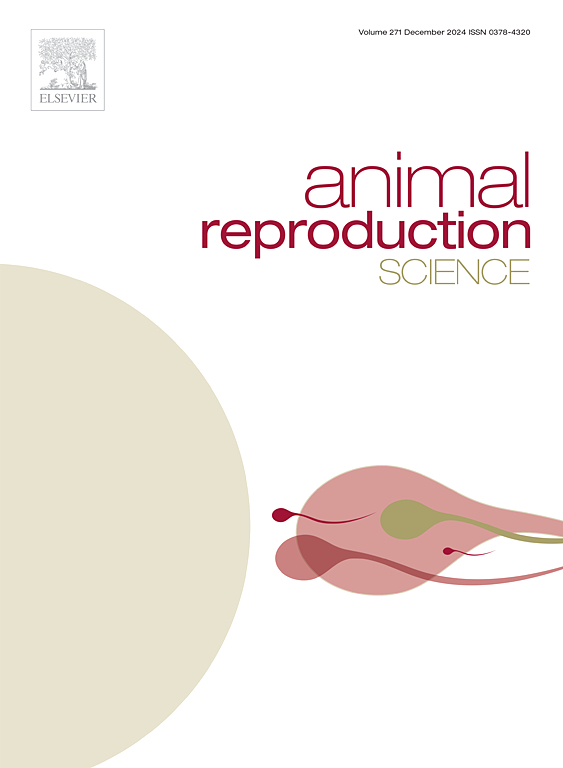In vitro effect of omentin-1 on level of other adipokines in granulosa cells from ovaries of Large White and Meishan pigs
IF 2.2
2区 农林科学
Q1 AGRICULTURE, DAIRY & ANIMAL SCIENCE
引用次数: 0
Abstract
Omentin-1, also known as intelectin-1 (ITLN1), is an adipokine produced by visceral adipose tissue and effect on improve insulin sensitivity, regulate energy metabolism and reproduction. Our previously data has shown that ITLN1 expression in porcine ovarian follicles is influenced by both the level of adiposity and the phase of the estrous cycle. Additionally, recent studies have indicated variations in the serum levels of adipokines in pigs with higher fat content, suggest their common interaction. It was therefore hypothesized that ITLN1 regulates the levels of other adipokines and their receptors in the ovary of pigs with different fat content. The aim of this study was to investigate the in vitro effect of ITLN1 (10–100 ng/mL) on the levels of other adipokines, namely adiponectin, apelin, leptin, chemerin, resistin, visfatin, and vaspin in the culture medium, assessed by ELISA. In addition, the effect of ITLN1 on the mRNA expression of the above-mentioned adipokines with their receptors was investigated using RT-qPCR in granulosa cells (Gc) from normal weight Large White (LW) and fat Meishan (MS) pigs on days 10–12 of the estrous cycle. The results showed that ITLN1 reduced apelin levels, increased leptin, and had no effect on vaspin in the culture medium. ITLN1 was found to have a modulating effect on the mRNA expression of the other adipokines with their receptors in porcine Gc. It can, therefore, be proposed that ITLN1 represents a previously unidentified auto- and paracrine regulator of the functions of ovarian microenvironmental compartments in different types of pig breeds.
网膜素-1(Omentin-1),又称内分泌素-1(ITLN1),是一种由内脏脂肪组织产生的脂肪因子,具有改善胰岛素敏感性、调节能量代谢和繁殖的作用。我们之前的数据显示,ITLN1 在猪卵巢卵泡中的表达受脂肪水平和发情周期阶段的影响。此外,最近的研究表明,脂肪含量较高的猪血清中脂肪因子的水平也有变化,这表明它们之间存在共同的相互作用。因此,我们假设 ITLN1 可调节不同脂肪含量猪卵巢中其他脂肪因子及其受体的水平。本研究旨在体外研究 ITLN1(10-100 ng/mL)对培养基中其他脂肪因子(即脂肪连通素、apelin、瘦素、chemerin、resistin、visfatin 和 vaspin)水平的影响。此外,还利用 RT-qPCR 技术研究了 ITLN1 对发情周期第 10-12 天正常体重大白猪和肥美眉山猪颗粒细胞(Gc)中上述脂肪因子及其受体 mRNA 表达的影响。结果表明,ITLN1 降低了培养基中 apelin 的水平,增加了瘦素,但对 vaspin 没有影响。研究发现,ITLN1 对猪 Gc 中其他脂肪因子及其受体的 mRNA 表达有调节作用。因此,可以认为 ITLN1 是一种之前未被发现的自体和旁分泌调节剂,可调节不同类型猪种卵巢微环境区划的功能。
本文章由计算机程序翻译,如有差异,请以英文原文为准。
求助全文
约1分钟内获得全文
求助全文
来源期刊

Animal Reproduction Science
农林科学-奶制品与动物科学
CiteScore
4.50
自引率
9.10%
发文量
136
审稿时长
54 days
期刊介绍:
Animal Reproduction Science publishes results from studies relating to reproduction and fertility in animals. This includes both fundamental research and applied studies, including management practices that increase our understanding of the biology and manipulation of reproduction. Manuscripts should go into depth in the mechanisms involved in the research reported, rather than a give a mere description of findings. The focus is on animals that are useful to humans including food- and fibre-producing; companion/recreational; captive; and endangered species including zoo animals, but excluding laboratory animals unless the results of the study provide new information that impacts the basic understanding of the biology or manipulation of reproduction.
The journal''s scope includes the study of reproductive physiology and endocrinology, reproductive cycles, natural and artificial control of reproduction, preservation and use of gametes and embryos, pregnancy and parturition, infertility and sterility, diagnostic and therapeutic techniques.
The Editorial Board of Animal Reproduction Science has decided not to publish papers in which there is an exclusive examination of the in vitro development of oocytes and embryos; however, there will be consideration of papers that include in vitro studies where the source of the oocytes and/or development of the embryos beyond the blastocyst stage is part of the experimental design.
 求助内容:
求助内容: 应助结果提醒方式:
应助结果提醒方式:


